Cultural charm
 0 Comment(s)
0 Comment(s) Print
Print E-mail Xinhua, December 24, 2019
E-mail Xinhua, December 24, 2019

For 9-year-old Liu Zhiyang, wandering through Everlasting Like the Heavens, a 99-day exhibition at Tsinghua University Art Museum, was one of the most exciting experiences she has had with her parents.
The exhibition features cultural relics from the Zhou (c. 11th century-256 BC), Qin (221-206 BC), Han (206 BC-AD 220) and Tang (618-907) dynasties, and celebrates the 70th anniversary of the founding of New China. Around two-thirds of showcased items reflect the spirit that flourished in those ages when many of China's traditions were developed and shaped.
"This exhibition aims to introduce China's vigorous and everlasting culture," curator Tan Shengguang says.
"Fine Chinese traditions have been passed down generation after generation. We hope the exhibition can help visitors find their roots and inspire their confidence."
Liu's father says: "Bringing my daughter to museums has been a frequent activity for my family. We want to let her better know our country's fine traditional culture and understand where she comes from."
The number of visitors to museums across China increased by 16 percent year-on-year to reach 1.13 billion in 2018, according to Liu Yuzhu, chief of the National Cultural Heritage Administration.
In 2018, museums across China held about 26,000 exhibitions and 260,000 cultural events, Liu says.
"With their numbers growing and their services improving, museums have become a new destination for people to spend festivals and holidays."
Liu Yuzhu says Chinese museums should market themselves as new spaces for get-togethers with family and friends so that going to a museum might become part of a "fashionable lifestyle".
This year, more Chinese people have found museums bridge their lives and traditional culture.

Getting trendy
Boasting over 17 million visitors in 2018, the Palace Museum, also known as the Forbidden City, has been particularly popular this year. Tickets to the museum were hard to get during the weeklong Spring Festival holiday, as the museum only allows 80,000 visitors a day. From Jan 5 to April 7, the museum hosted an exhibition featuring Lunar New Year traditions. The entire Forbidden City was adorned with lanterns, paintings and couplets to create an immersive experience.
"The museum has tried to stay relevant to contemporary visitors in every detail," says Ren Wanping, deputy director of the museum.
The museum has also seamlessly associated itself with "being trendy".
Lantern Festival in the Forbidden City, held for two consecutive nights, invited thousands of people from all walks of life, including model workers, couriers and sanitation workers to enjoy the magnificent views of the lit-up palace. It was the first time the museum had opened to the public for free at night in its 94-year history.
The Palace Museum is time-honored for its rich history and representation of traditions, says Liu Yican.
"It is also 'young' in my view because it serves and passes fine traditional culture to today's youth," the 26-year-old says.






Go to Forum >>0 Comment(s)